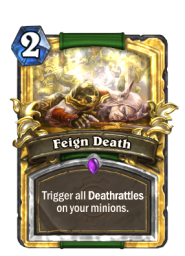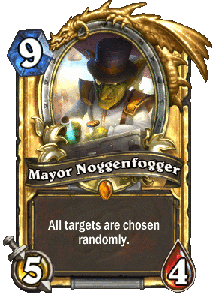I think we’ve all had that moment in Hearthstone when you play a card  expecting one thing and then the total opposite happens. Mine was with Feign Death and Sylvanas Windrunner. Playing Feign Death would have been a huge tempo swing for me, but despite having enough mana to play the spell, I ended my turn. My husband, watching the match, exclaimed, “Why didn’t you play Feign Death?!” Confused, I responded, “Because I don’t want Sylvanas to die yet.”
expecting one thing and then the total opposite happens. Mine was with Feign Death and Sylvanas Windrunner. Playing Feign Death would have been a huge tempo swing for me, but despite having enough mana to play the spell, I ended my turn. My husband, watching the match, exclaimed, “Why didn’t you play Feign Death?!” Confused, I responded, “Because I don’t want Sylvanas to die yet.”
Because I had no experience with Feign Death, I didn’t know that the card triggers the Deathrattle without destroying your minion. Instead, I incorrectly interpreted the card text thinking it would trigger the Deathrattle prematurely.
Inconsistent and ambiguous card text isn’t a new discussion within the Hearthstone community. Meme-lord Disguised Toast often points out these inconsistencies, among other bugs. So if this is a known issue, why talk about this now?
Recently, Disguised Toast revealed the card Madam Goya for the new expansion “Mean Streets of Gadgetzan.” I watched the reveal live and after his video, someone in chat asked, “Is the card swapped a random minion?” Toast had no clue. He had to actually play the Madam Goya again to remember that it was indeed a random interaction. He later pointed out the inconsistency with Barnes, which was a card released in August.

Why do we have to still ask whether or not a card interaction is random? This lingering question is one of the reasons for this post. But my main motivation is the new card, Mayor Noggenfogger.
Understanding Context and Language

The irony of this card’s flavor text is not lost on me: “This flavor text was randomly generated. If it happens to form words and make sense, that is purely by chance.”
Mayor Noggenfogger frustrates me to no end. Upon first reading the card, I kept asking, “What does his text mean?” I had to stop, think, and even talk through the card with my husband: Spells are random but now everything is random? What about minions? Does this affect heroes with weapons? If you attempt to attack does that mean the card redirects you and/or your minion? In short, I was really confused for a good half hour because I had no context to understand how the card technically functioned. Additionally, the card text was short, but I found it wasn’t really informative.
In concise writing, you want to trim down the language and say exactly what you mean in the fewest words possible. Additionally, you need to be contextually aware of the task and how the user performs that task.
A good example of effective language and context is the Discover keyword. The Discover mechanic debuted in a Tavern Brawl, and the Brawl first explained the mechanic and then let the player test the mechanic. When “League of Explorers” launched, the Discover keyword did not need to be explained through the card text because players already understood how Discover functioned.
Now let’s look at the Mayor’s language. While random spells are common, the problem is that there are very few minion cards that have random targeting. After some thinking, I remembered that ogres have similar behavior. Their card text is some variant of “50% chance to attack the wrong enemy.” When you attack with a minion, you have to target that minion. Therefore, the key in this analysis is the implied use of target and the action of the minion attacking a random character/enemy. So by understanding how ogres work, we can assume that Mayor Noggenfogger creates an aura that makes all character attacks (heroes, hero powers, and minions) and targeted spells affect random characters, including buffs and heals.
But do we understand how his aura works for sure? No. In fact, I question whether or not the Hero is also affected. Why? First, because of the use of target over character. Second, because of context. Ogres are the only cards in the game with somewhat similar behavior and they are rarely played. In fact, that Mayor’s aura is completely unique. Consequently, the Mayor’s mechanic has no context to existing players and therefore warrants further explanation for technical clarity.
Now that I’ve dissected the meaning, here is my suggested text:
- All characters, Hero Powers, and spells now have random targets.
This is intentionally descriptive, and, while not necessarily perfect, describes the mechanic explicitly and concisely.
What does this imply about card text overall?
From my observations, my own experience with writing software UI text, and  knowing technical communication theory, I believe there are two main inconsistency issues in Hearthstone card text:
knowing technical communication theory, I believe there are two main inconsistency issues in Hearthstone card text:
- Describing random mechanics and interactions.
- Describing aura effects—i.e., cards that always have their effects in play.
There are other issues; however, from a preliminary view many of these are based on newer iterations of describing established mechanics and not updating the older descriptions (See Reno Jackson’s original text and Kazakus).
My point is that card text consistency isn’t a straightforward issue. Part of it is iterating on mechanics and finding time to clean up the older, existing content. The other part is coming up with a standard for mechanics other than keywords and consistently adhering to them, while understanding the contextual knowledge of the primary audience, who are defined as causal players. Balancing both of these, especially in constrained writing spaces, is difficult but it can be accomplished.
When I finish my thesis, I would like to explore the two issues outlined above in more detail from the technical communication lens to provide solutions based in user-centered theory.
I hope you enjoyed this semi-academic deep dive. Let me know what you think about my analysis and your own experiences and thoughts.
